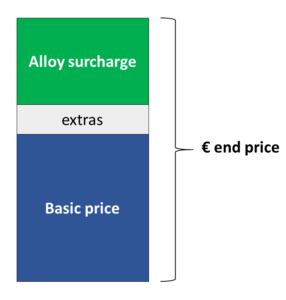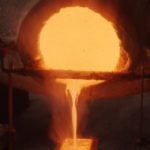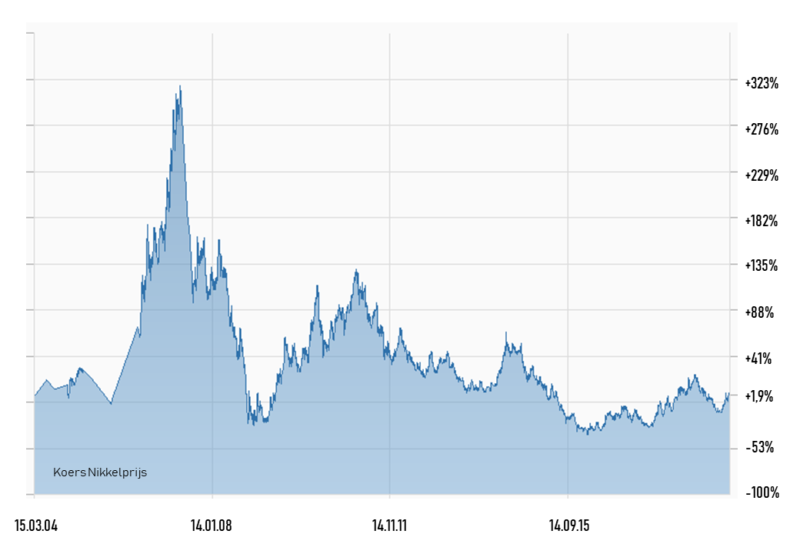The alloy surcharge for stainless tubes. What is it and why?

Companies that regularly order stainless steel tubes are all too familiar with the concept of alloy surcharge. The first month it rises and the second one it falls again. Have you ever wondered why this happens or how this allowance is actually determined?
The best known surcharge: fuel
A surcharge is introduced more often to reimburse highly variable-priced components. One of the best known surcharges is of course the fuel surcharge. When fuel costs started to fluctuate sharply a couple of years ago, transport and freight companies had little opportunity to pass on additional costs due to current contracts, price agreements and competition. The fuel surcharge was introduced as a method to be able to pass on variations in fuel costs on top of the agreed price.
What is the alloy surcharge?
The price of stainless steel tubes consists of three components: the basic price, the extras and the alloy surcharge. The basic price is the price on which all steel mills make their price agreements with customers such as tube manufacturers. This component includes raw materials, labor costs, production costs, etc. Depending on customer requirements and possibilities, this is also the price which Versinox communicates.
 The component “extras” often contains costs that are not material specific, for instance transportation cost.
The component “extras” often contains costs that are not material specific, for instance transportation cost.
The alloy surcharge is the price component to pass on the highly volatile alloy costs. Alloy surcharges are product-specific because metal grades have different compositions. Usually, steel mills work with a monthly average and alloy surcharges are therefore also published on a monthly basis by the manufacturer.
Stainless steel: five variables
 The alloy surcharge for stainless steel was introduced for the same reason as it was for fuels. The alloy surcharge is based on the price level of the five main elements used in the production of stainless steel: nickel, chromium, molybdenum, manganese and iron. The prices of these elements have become highly volatile since around 1988. And where only the fuel price is the only factor in the fuel surcharge, stainless steel has five! To prevent new price agreements having to be made several times a year, a number of steel manufacturers therefore applied a surcharge that was solely dependent on the price level of used alloy elements. In this way, monthly price variations of the alloy elements could be absorbed with a price correction on top of the basic price.
The alloy surcharge for stainless steel was introduced for the same reason as it was for fuels. The alloy surcharge is based on the price level of the five main elements used in the production of stainless steel: nickel, chromium, molybdenum, manganese and iron. The prices of these elements have become highly volatile since around 1988. And where only the fuel price is the only factor in the fuel surcharge, stainless steel has five! To prevent new price agreements having to be made several times a year, a number of steel manufacturers therefore applied a surcharge that was solely dependent on the price level of used alloy elements. In this way, monthly price variations of the alloy elements could be absorbed with a price correction on top of the basic price.
Formulas were developed depending on the composition used per quality. Because the alloy surcharge is an important price component, it also has the warm attention of cartel authorities. They prohibit all forms of cooperation or agreements in this area, blocking a standard surcharge for all steel manufacturers. That is why every steel manufacturer uses a slightly different formula to calculate the monthly alloy surcharge and these may so differ from each other.
What does the amount of the alloy surcharge depend on?
Although the calculation formulas are not public, for the different mills they seem to be roughly the same. For the calculation, it is first determined per alloy component what the average value in dollars was over a certain period. The contribution to the surcharge is determined in combination with the average percentage of the element used in the alloy and converted into euros. The amount of the alloy surcharge is highly dependent on the worldwide supply and demand for the five elements mentioned. For example, in the period 2002-2007, China transformed from the world’s largest importer into the largest exporter of stainless steel. The volumes that accompanied this change also had an impact on the nickel price, which rose more than 300% in a short time. For quality 316, we saw the alloy surcharge rise in this period from € 0.45 / kg to over a € 6 / kg! The alloy surcharge is currently fairly stable between € 2 and € 2.50 / kg

Fixed price agreements or speculation?
Of course there is a certain temptation to speculate with the alloy surcharge when purchasing stainless tubes. But since the tube is a very large price component for most Versinox customers, they generally benefit from stable prices. This means that most contracts, both project orders and annual contracts, are concluded including a fixed surcharge. In this way the tube producers can also fix their purchasing prices, including alloy surcharges, for a longer period and keep prices stable for that time.
Want to know more about actual alloy surcharges? Please don’t hesitate to contact us. We’re happy to help you.
Sources:
lz-prognose.de
rolledmetalproducts.com
outokumpu.com
Share this:



